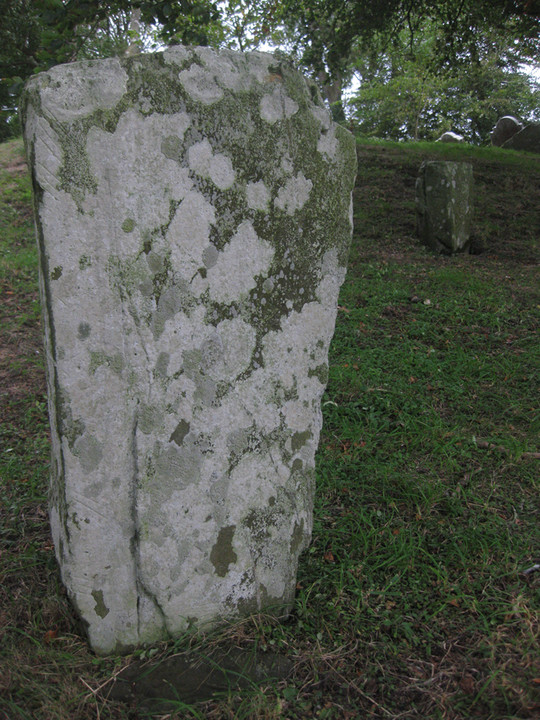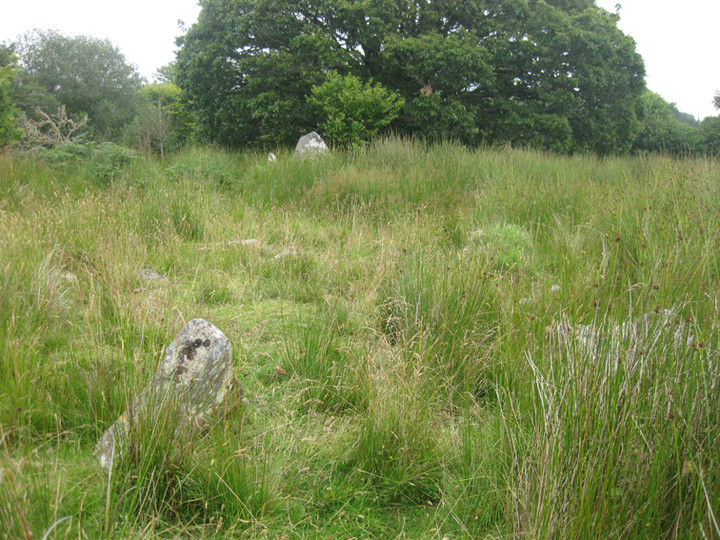





Marked as a mound on the OS map, this could be the remains of a wedge tomb or the remains of a habitation site, or something else entirely. There was too much vegetation and destruction to work out which.



Over the round structure, towards the 3 metre tall stone, in this multi-faceted, multi-period place.

Standing stone, with beehive hut/souterrain to the left.


The very small gallery, with metal girder supporting the front roofstone.


I’m all for the preservation of articles of our ancient past, but hold on a minute with the fencing.

There are quite a few mounds in the field here. This is not the mentioned one – that’s enclosed by the fence to the right.


The mound is encircled by awful fencing and, by the looks of it, is going to survive the fake boom that was the Celtic Tiger only because of the economic collapse.

The overgrown mound is cut into by the house boundary wall.

The view across to Ireland’s Eye from in front of the mound.

The lake is maybe 150 metres from the sea. Is it freshwater? If yes, is that why the mound is here?

Across the lake, between the two houses, is the mound




29/8/11
Kileen Cormac cemetery, said to contain a passage grave. Maybe, maybe not.


The folklore of Ireland’s ancient monuments
A not very strenuous walk from the parking area south of the peak (lots of scorch marks from the burning of cars, glass on the ground from broken car windows – park at your own risk) leaves you in the tangle of masts and fences that contains this ancient tomb.
If all the modernity wasn’t here, this would be a beautiful place, with views over the midlands plain to the whole of the west as far as the Slieve Blooms and further, north as far as the mountains of south Armagh, and over to the last of the Dublin/Wicklow hills around Newcastle. As it is this is a well-used place: mountain bikers, dog walkers (and their left behind dogshit) and the clatter of masts and buildings in varying states of decay.
It was a nice walk and the tomb in as unremarkable as I remembered, 3 structural stones visible, robbed out (or excavated) at the top, with no sign of a passage or chamber. It rises to a height of about 3 metres and there are some outlying stones on the west side that may be part of a kerb. I wanted to take in something neolithic on our walk today and was happy I came here.



In the National museum on Kildare St. is a very poor re-construction of a passage tomb. This stone is to the right of the entrance to the ‘passage’. The information sign says it come from Tornant Upper destroyed passage tomb.
Permission refused for proposed Slane bypass
An Bord Pleanála has refused permission for the proposed Slane bypass in Co Meath, a decision which has infuriated some local residents.
Local residents who had been campaigning for a bypass are angry
An Bord Pleanála has confirmed it has refused permission for the proposed Slane bypass in Co Meath.
The agency decided to reject the planned bridge and roads around the village because the proposal was located very close to the World Heritage Site at Brú na Bóinne.
Other factors included the belief among board members that it had not been proven that no appropriate alternative was available, and it could have diverted traffic off the M1 tolled motorway.
An Bord Pleanála’s decision has been greeted with anger by local residents who had been campaigning for a bypass.
Residents say the bypass is essential to improve road safety in the area.
They claim that 22 people have died in accidents on the bridge or on its approaches and are warning more could die as a result of today’s announcement.
The Bypass Slane Campaign said it is ‘’shocked and dismayed’’ by the decision. The group was formed in April 2009 in the aftermath of a serious road traffic incident in the village.
In a statement, it said: ‘’Life in the village, over generations, has been overwhelmed by the dangerous volumes of traffic and by the constant threat to life it brings.
More here: rte.ie/news/2012/0307/slane.html
A 64-year-old farmer has been fined €25,000 at the Circuit Criminal Court in Tralee for destroying a 1,000-year-old ringfort, which was a protected national monument.
In one of the first prosecutions of its kind to come before the courts, John O’Mahony pleaded guilty to carrying out work on the fort on his farm at Causeway in Co Kerry in February 2008, without notifying the National Monuments Service in advance.
More here:
rte.ie/news/2012/0302/omahonyj.html
Music could have been an inspiration for the design of Stonehenge, according to an American researcher.
Steven Waller’s intriguing idea is that ancient Britons could have based the layout of the great monument, in part, on the way they perceived sound.
He has been able to show how two flutes played in a field can produce an auditory illusion that mimics in space the position of the henge’s pillars.
Mr Waller presented the idea at the AAAS meeting in Vancouver, Canada.
By Becky Evans
Digging For Britain
New investigations at an iconic cave site on the Channel Island of Jersey have led archaeologists to believe the Neanderthals have been widely under-estimated.
Neanderthals survived in Europe through a number of ice ages and died out only about 30,000 years ago.

The post is about 4 and a half foot high

Close-up showing the destruction at its worst


The entrance to the northern tomb. The first chamber of the gallery has been removed.

Two jambstones and a displaced lintel at the entrance to the northern tomb.


Second chamber of the northern gallery of this dual-court tomb.

Difficult to make out the layout as much of the tomb remains within its cairn.


Wall on the south side of the tomb, most of which is still in its cairn.



